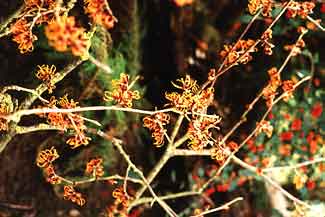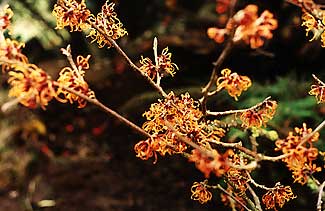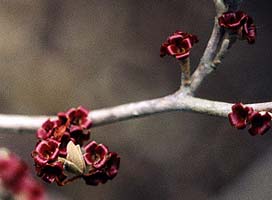 | |
|
Ouphe & goblin! imp & sprite! Elf of eve! & starry Fay! Ye that love the moon's soft light, Hither„hither wend your way; Twine ye in a jocund ring, Sing & trip it merrily, Hand to hand, & wing to wing, Round the wild witch-hazel tree. Hail the wanderer again, With dance & song, & lute & lyre. Pure his wing & strong his chain, And doubly bright his fairy fire. Twine ye in an airy round, Brush the dew & print the lea; Skip & gambol, hop & bound, Round the wild witch-hazel tree. The beetle guards our holy ground, He flies about the haunted place, And if mortal there be found, He hums in his ears & flaps his face; The leaf-harp sounds our roundelay, The owlet 's eyes our lanterns be; Thus we sing, & dance, & play, Round the wild witch-hazel tree. -Elfin Song, | |
Witch Hazel,
A Bloomin' Favorite in Winter
Asiatic species of Witchhazels are among the most exciting shrubs & small trees for the winter garden, not only for the beautiful form of their gnarly limbs & scaly bark, but most especially because they are in full bloom a couple weeks after Christmas.
In Autumn they have splendid leaf colors, as can be seen on the page with the article What a Charmnut is Witchhazel & on the Witchhazel page of the Autumn Leaves Gallery, plus additional portraits of autumn leaves & winter flowers with the article Medicinal Uses of Witch Hazel.
By the very end of October or early November, the limbs are bare, except for whatever old horned nuts still cling from the the year before, & new eency buds. In December a few long-lasting blooms appear, then in January, woo-hoo!
The genus name is easily misunderstood as alluding to a reputed resemblance to an apple or pear tree, which it does not in any manner resemble. What the name actually intends to indicate is that the fruits remain on the branches so long that come winter when it blooms, it still has nuts on its branches. Thus Hamamelis combines a name Hippocrates used for the medlar's fruit, with a Greek word for "together," meaning the fruit & the flowers occur together.
The common name is thought to have been coined in colonial America, when a forked branch of H. virginiana was the first-choice for "water-witching" in deciding where to dig a well, as discussed at greater length on the American Witchhazel page.
It has many other names like Snapping Hazelnut because each nut explodes a pair of seeds a considerable distance with a loud "snap!"; or Winterbloom for equally obvious reasons.
It has also been called Bending Alder or Bent Elder because of the crooked limb habit. It was also called Tobacco Wood because American species of hazels as well as chestnuts, pines, & some other woods were used to carve smoking pipes; it was sometimes specified as Snapping Tobacco Wood to not be confused for other choices.
 But the name witchhazel, witch-hazel, or Witch Hazel is its best & most popular moniker, being indeed associated with witchcraft, midwifery, the land of fairy, & folk medicine.
But the name witchhazel, witch-hazel, or Witch Hazel is its best & most popular moniker, being indeed associated with witchcraft, midwifery, the land of fairy, & folk medicine.The top two photos on this page were taken the first week in January, of our asiatic specimen, the Jelena Witchhazel (Hamamelis x intermedia 'Jelena'), one of many notably colorful hybrids reliant on H. mollis brought to North America from China early in the 20th Century, & hybridized with H. japonica.
'Jelena' was developed in Belgium & from it many other fine cultivars have been developed. As our witchhazel is fairly sheltered, the blooms persist through February into the front of March, very long lasting.
When blooms are finally spent, through March & April we are still blessed by the hard base of the flowers decorating the limbs, for these bases look like hard-petalled burgandy flowers that only slowly become hidden as budding leaves develop. The third picture, here at the left, taken the third week in March, reveals this attractive "after-blossom."
 One January we took a trip to a nursery that bucks the system of nurseries going quiescent in winter, & which stocks in lots & lots of winter-choices for gardeners who can't wait till spring. The nursery had an area with scores of witchhazels in a half-dozen varieties, large ones & small ones. It was exciting to saunter around a veritable forest of winter witchhazels in full bloom.
One January we took a trip to a nursery that bucks the system of nurseries going quiescent in winter, & which stocks in lots & lots of winter-choices for gardeners who can't wait till spring. The nursery had an area with scores of witchhazels in a half-dozen varieties, large ones & small ones. It was exciting to saunter around a veritable forest of winter witchhazels in full bloom.With a little extra delight we did notice that of so many wonderful cultivars, very few equalled (& none exceeded) the beauty of our 'Jelena's' multicolors of red & copper & yellow & orange & white on every bloom.
The majority of the varieties have yellow blooms, ranging from deep yellow to so pale they are nearly white. But one variety derived from the 'Jelena,' but called 'Diane,' has blooms that are startlingly red.
We also have in our garden the native American Witch Hazel, H. virginiana, which has to great extent been shoved aside by the nursery trade in preference to the larger-flowered Asian cultivars with their showier winter leaf color. But the native witch hazel deserves as much attention. In our garden the American witch hazel blooms late autumn or early winter, thus extending the length of time there are witchhazel flowers in the winter garden, & the tinier bright yellow spider-flowers rank well ahead of the Asian varieties for fragrance.